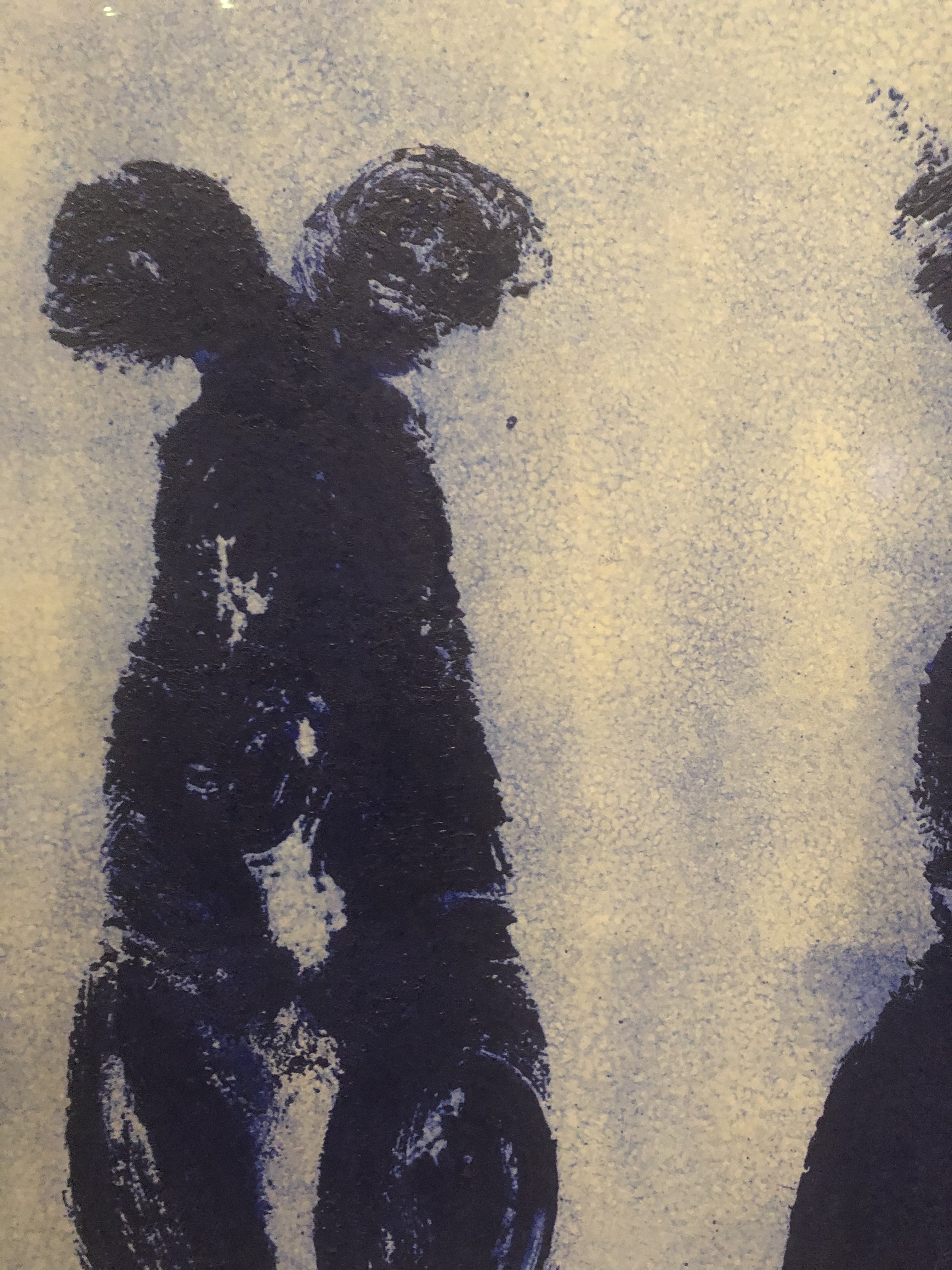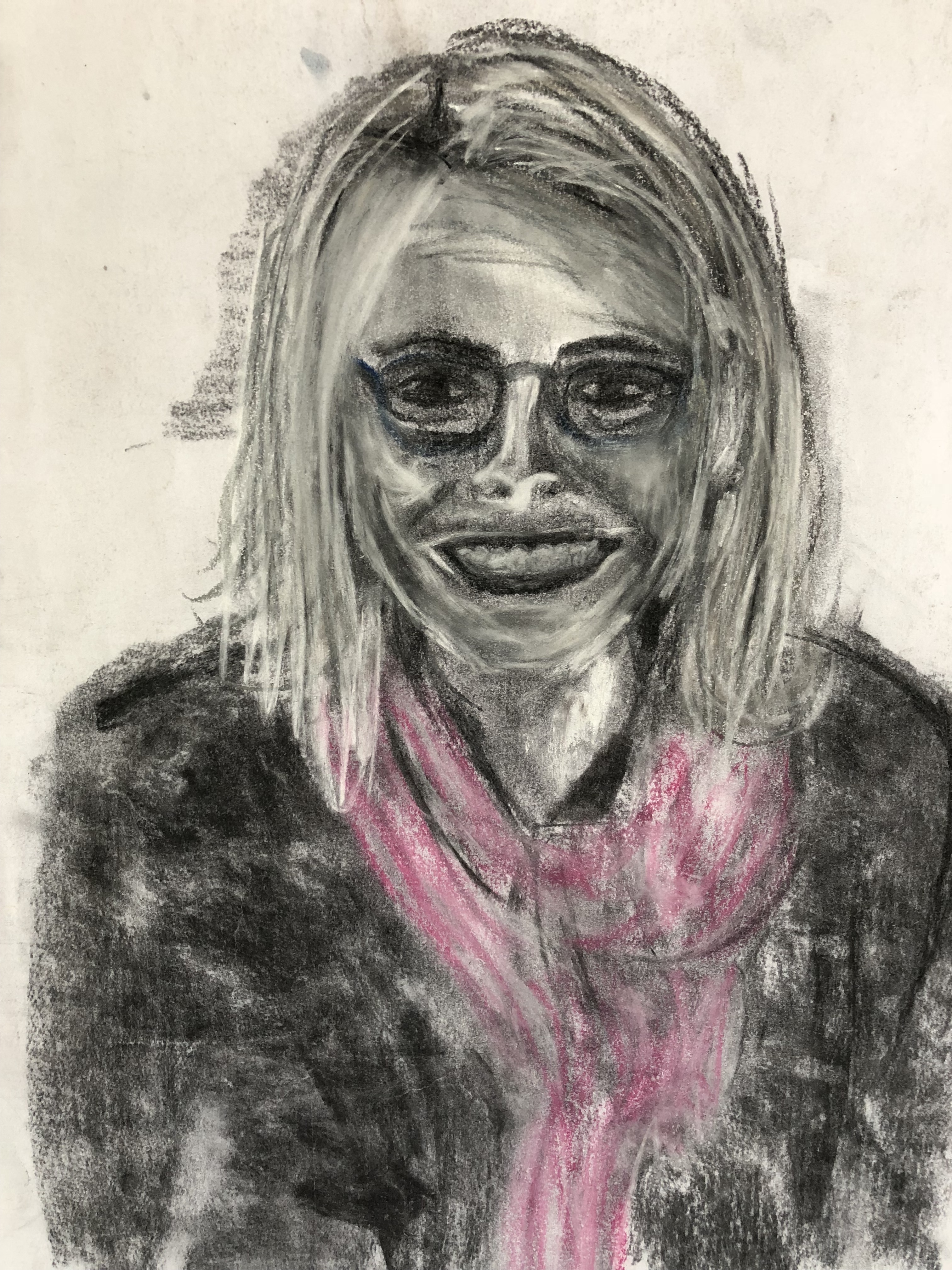10 October 2018
Thoughts to carry with me for the rest of the course.
Experimenting with art looking at Diptych:
Traditionally, diptychs were hinged like books that could be folded. In modern art, it is common for artists to create two separate panels designed to be hung next to one another. Other artists may choose to create the illusion of a diptych on a single panel. This can be done in any number of ways, including a painted line to divide the piece or a single mat with two windows cut into it.

Above images were drawn after an early morning walk – shadow of my image. Reminded me a movement, yet also a frozen moment in time. The arm holding the cellphone to take the picture, is shown cut off – like the statue of Venus de Milo, my pose has some resemblance – I am thinking of emphasising this – can also show the body shapes with forms by doing this.

Below are works I photographed whilst visiting the Louvre, AbuDabi. Frenschman Yves Klein and Japanese artists Kazuo Shiraga during the 60’s created works using their bodies in direct contact wiht material, capturing movement or action on the canvas. The works I viewed were the bodies of Klein and his wife.


I kept a piece of paper from a cyanotype I attempted as I could see a figure in the print. I decided to draw with conte white and black chalk sticks on it. I am happy with the mood it creates and are contemplating further studies.

Gesture drawing
The idea of capturing a figure in a short moment – capturing the true spirit of each pose/gesture.
When reading about the sculptor Antony Gormley, his drawings intrigued me and I searched more about his drawing processes and materials he uses. The drawings in the Red Earth series were made from red-coloured earth collected originally by the artist from the Lot region in France and mixed with rabbit skin glue and water. Black pigment is still present – used either to shade in entire areas or to pick out individual elements within the composition.
Gormley had been seeking to test his own classic Western frame of reference against other traditions – an impulse that was given further impetus in the early 1980s by his encounter with Joseph Beuys’s notion of a widened field of art and call for an anthropological art. For Gormley this meant that putting art “to the practical service” of life in order to “make something with power”. The use of earth has a long prehistoric tradition in terms of mark-making, and this ties in with the artist’s notion that “drawing is a site where something has occurred geologically”. The drawings are thus a powerful repository of thought and reflection in terms of both historical and pre-historical concerns.’
Text by Anna Moszynska, from ANTONY GORMLEY DRAWING, published by The British Museum Press, London, 2002
VO COLLABORATION, 1984
‘These large, landscape-format drawings made principally on the wall in pencil with some traces of pastel and charcoal, were produced in Peckham when the artist was looking after his toddler son. The infant Ivo would scribble on the page alongside his father. Gormley, having drawn the main image, would choose a title, write it out as a single word along the base of the drawing, then add selections from a dictionary definition in pencil. While the choice of the individual words appears significant in terms of his developing sculptural concerns, it also reflects Gormley’s haiku-inspired writing practice seen in the texts and word chains of his sketchbooks at this time, and in some of his later published pieces. The preference for short single-word titles is reflected in several of the lead sculptures of this period which have similar names, including LIFT (1983), RISE (1983-4), PEER (1984) and PROOF (1984). It is noticeable how some of these “collaborative” drawings include nature in a very direct way – squashed butterfly wings or mouth imprints on the paper, prefiguring the use of unusual or idiosyncratic natural and chemical substances in later drawings. In reflecting upon the series, Gormley comments: “I loved the whole playing aspect of the drawings – Ivo doodling and chatting, [me following a] stream of consciousness and getting flashes of image from this and the traces on the paper. It was as if drawing was a recorded conversation but free of logic, just playing”.’ (wow for me!)
Text by Anna Moszynska, from ANTONY GORMLEY DRAWING, published by The British Museum Press, London, 2002.
BERMUDA DRAWINGS, 1998
‘By the second half of the 1990s, Gormley found that drawing was increasingly becoming something that he would do while travelling, as this tended to be the only time that he “could get away from making sculpture”. This sequence of drawings was made in Bermuda in 1998. During a trip to install a sculpture in the Caribbean island, using the only drawing paper he could find, Gormley produced these “fluid, flimsy works”. His free associations touch upon the themes:
- “over the edge
- under the sea
- out in space
- beyond the pale.”
When travelling, the artist habitually carries materials with him from home (in this case, pigment) and uses others (here, tissue paper and copper sulphate) that he finds at hand on site. Creating one drawing after another, he develops an idea and keeps it going through the momentum of the flow of making in a single intense session of activity.’
Text by Anna Moszynska, from ANTONY GORMLEY DRAWING, published by The British Museum Press, London, 2002

Making casein:
Modern adoption has been greatly boosted by the availability of casein emulsion, a formulation of casein and drying oil that does not readily spoil and is available in tubes.
To make “true” casein, vinegar is used to separate out the liquid whey, leaving the curdled milk protein — essentially cottage cheese. This is dried and ground to a powder for future use or used immediately, and usually mixed with water and ammonium carbonate or clear liquid ammonia (though there are other formulations using lime or borax). The result is a milky fluid into which powdered pigments are mixed to make paint.
I have been looking at youtube videos of Karl Grass ( spiritofthepose.com) and his focus on the “bedrock skills” of drawing a figure has taken me to looking at how I begin to draw, some of my habits that need to be undone, need to be willing, regardless of how it looks or appeal to myself and or others, to push through and learn. He pushes to “find a voice that does not need approval” – a need to go down the road, like Alice in Wonderland, and explore, just what is in front of you, now history. His emphasis on asking, ” why you are drawing” is intriguing: ‘what is my subject doing?” and then to find the relative long lines and relative proportions – set the drawing right for expression and balance and represent the “spirit of the thing” is exhilarating at this stage!
Collage
I like the work of artist, Hannah Hoch. She is known for collages and photo montages. She astutely spliced together photographs or photographic reproductions she cut from popular magazines, illustrated journals, and fashion publications, re-contextualizing them in a dynamic and layered style. She noted that “there are no limits to the materials available for pictorial collages—above all they can be found in photography, but also in writing and printed matter, even in waste products. In her work she explored identity and gender. She was part of the Berlin Dada Group. She would combine contemporary women with women from non Western culture for her Indian Dancer – a cut out mask and domestic crown is on the picture of a filmstar.
- beginning the drawing more cautiously – softer and lighter lines
- I find myself to quickly with ‘finished’ lines which are not correct
- showing and looking for comparative measurement – length of the hand, width of the hand/ compared with the jug
- using value – high light and shadows
- create volume and form – seek for the form under the flesh ( use halftones, linear hatching or rendering) find the turns of the cubes and cylinders and turn them gradually.
Self portraits – am thinking about my ageing process which seems something I am more aware of. I decided to use old self portraits and ID/Passport photos and make a collage and then re or (de) construct an image from that. It makes me think if it is something I would like to hold on to – images of myself, of love ones, of places and things I treasure and do not want to forget. Art can help to preserve experiences and memories.. I am also aware of reality, that is not to idealize images – in a way I like portraits that show sorrow, challenge our moralities, self understanding, knowledge, sensitize and create an experience.


Charcoal on canvas paper and diluted watercolour. I like the uncontrollable event that could happen – adds to looseness and character within the drawing.

Above is an ink and cyanotype experiment in my sketchbook – would like to explore this more on Hannemuhle etching paper.

Charcoal drawing on white paper

Continue with above – ink, jik, more lines
Added the Cyanotype and left it in the sun for 5 hours.

Note to self: work on at least waterpaint quality paper and submerse the paper in a bath of water. The paper toar ( over the nose and eye part) as I did not put it in a bath of water, put rinsed in under a tap – the fibres of the paper are not strong enough for this ‘abuse’. I love the idea that I used rocks and tree pods to create marks on the face during the exposure to light.

Charcoal and pastels on homemade textured paper


Lessons learn at this stage:
I need to work with a regular model at least 2 x p week. Daniel Maidman shared on his blog as a note to myself:
“There were three primary techniques I used to improve:
1. For drawing, I went to open life drawing workshops between once a week and three times a week for seventeen years.
2. For painting, I ultimately wound up spending hundreds of hours working privately with models from 2004 to the present.
3. For general anatomy, I spent two years drawing my own anatomical atlas based on human cadaver dissections which I attended or performed, at Santa Monica College.”
(hmmm not so sure about human cadaver dissections!)
I found that it is very difficult to attend a life drawing class here in Dubai – I am still searching and believe I will find something practical.
I have tried to find some kind of solution by using video footage and you tube figurative options. I also think doing more self portraits will be necessary to learn and grow my own style of interpreting the figure.